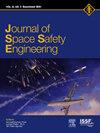利用近地轨道碎片环境演变模型评估轨道碎裂的影响
IF 1
Q3 ENGINEERING, AEROSPACE
引用次数: 0
摘要
这项研究评估了反卫星试验、两个物体之间的碰撞和爆炸等轨道碎裂对环境的影响。九州大学和日本宇宙航空研究开发机构联合开发了一个名为 NEODEEM 的碎片环境演化模型,该模型用于预测未来的碎片群并计算碎片发生后的碰撞概率。这项研究的重点是碎裂物体的特征,如高度、质量以及是否属于大型星座(LC)。当碎裂发生在较高的高度时,新的碎片会在轨道上停留很长时间。由于这种积累,碎片不仅会使天体数量和碰撞概率保持在较高水平,还会造成碎片与背景天体发生二次碰撞的风险。当碰撞发生在高度较低的低地球轨道内时,由于大部分碎片衰变较快,因此碰撞将是短期的。然而,由于许多卫星在同一高度运行,会合(即运行道路)的数量将迅速增加。考虑到大于 1 厘米的碎片体积较小,本研究还讨论了与低地球轨道的碰撞概率。本文章由计算机程序翻译,如有差异,请以英文原文为准。
Assessments of the impacts of orbital fragmentations using the Near-Earth Orbital Debris Environment Evolutionary Model (NEODEEM)
This study evaluates the environmental impacts of orbital fragmentation such as an anti-satellite test, collision between two objects, and explosion. A debris environment evolutionary model named NEODEEM, jointly developed by Kyushu University and JAXA, is used to predict future populations and calculate collision probabilities after a fragmentation. This study focuses on characteristics of the fragmented objects, such as altitude, mass, and whether they belong to a Large Constellation (LC). When a fragmentation occurs at higher altitudes, the new fragments will remain in orbit for a long time. Due to this accumulation, the fragments will not only keep the number of objects and probability of collision higher but also cause the risk of secondary collisions between fragments and background objects. When a collision occurs inside an LC at a lower altitude, the impacts will be short-term because most of fragments decay quickly. However, the number of conjunctions, i.e., operational roads, will increase rapidly because many satellites are operated at the same altitude. This study also discusses a collision probability to an LC taking into account the small size of fragments larger than 1 cm.
求助全文
通过发布文献求助,成功后即可免费获取论文全文。
去求助
来源期刊

Journal of Space Safety Engineering
Engineering-Safety, Risk, Reliability and Quality
CiteScore
2.50
自引率
0.00%
发文量
80
 求助内容:
求助内容: 应助结果提醒方式:
应助结果提醒方式:


